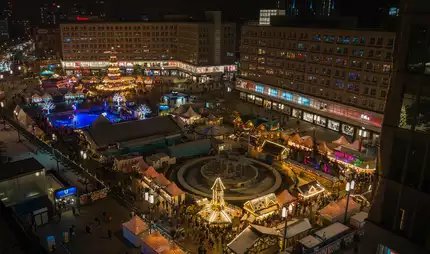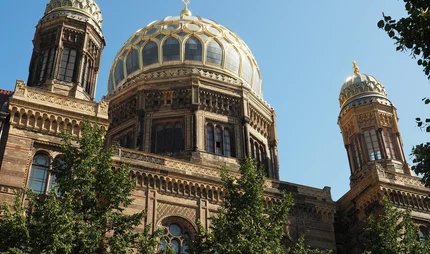
Hackesche Höfe
Traditional Berlin courtyards at Hackescher Markt
The Hackesche Höfe are one of Berlin’s most popular attractions – don’t miss the impressive Art Nouveau façades and the special atmosphere!
No visit to Berlin is complete without a trip to the Hackesche Höfe. Ever since reunification they have been one of the main meeting points for scenesters and tourists alike. The complex is in the historical Scheunenviertel area of Spandauer Vorstadt in Mitte. They are the largest single courtyard complex in Germany and have been listed buildings since 1972.
Scheunenviertel and Spandauer Vorstadt

In the 17th century, the area where the Hackesche Höfe are now located wasn’t even part of Berlin. There were lots of barns there for storing hay and straw, which couldn’t be kept in the city because of the fire risk. Although the area around Hackescher Markt has long since been part of the city centre, it’s still called the Scheunenviertel (Barn Quarter) today.
By 1700, many people had settled outside the city walls in the area that became known as the Spandauer Vorstadt. It even had its own church. In 1731 it became part of Berlin when the Prussian king Friedrich Wilhelm I had the city walls extended. Shortly afterwards, Hackescher Markt was build according to the plans of the city commandant Hans Christoph Graf von Hacke.
Jewish residents in particular settled in the area around Hackescher Markt in the following years, and a vibrant Jewish community developed. The Jewish cemetery was opened on Große Hamburger Straße, and in 1866 the synagogue was built on Oranienburger Straße, where it still stands today.
The history of the Hackesche Höfe
The courtyard complex opposite Hackescher Markt was opened on 23 September 1906 after several years of construction. It was designed and built by the architect Kurt Berndt, and the Art Nouveau façade was the work of August Endell. As with many Berlin courtyard buildings, the complex is used for a mixture of offices, shops, workshops (particularly in the front courtyards) and flats.
The buildings were only partially damaged during the Second World War, but became increasingly dilapidated while Germany was partitioned. They were state property in the GDR and neglected at the time.
Only after reunification, starting in 1993, was the complex extensively restored at a cost of 80 million deutschmarks, and it soon became a magnet for tourists.
The Hackesche Höfe today: restaurants, bars and shops

The original use of the buildings was included in the restoration concept and successfully implemented. Today, the eight courtyards of the Hackesche Höfe between Rosenthaler Straße and Sophienstraße have 27,000 square metres of space for 40 businesses, including cultural institutions, a cinema, cafés, shops and apartments.
All around the Hackesche Höfe, bars, restaurants and clubs have opened, and the area is now one of Berlin’s most popular places for nightlife.
The courtyards with apartments are closed at night, but the front courtyards with bars, the cinema and theatres are always open.
Travel and parking
It’s always busy around the Hackesche Höfe and Hackescher Markt, and there is hardly anywhere to park. We therefore recommend getting there by public transport. The S-Bahn, U-Bahn, trams and buses all stop at Hackescher Markt.
Nearby attractions
Near the Hackesche Höfe you will find numerous other sights.




